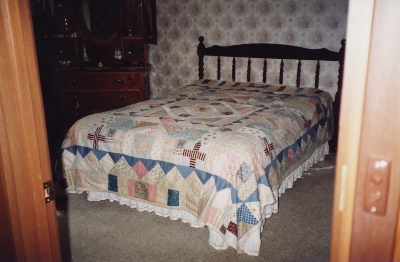Quilt No.194FW - Fred Wood
...
Made by Charlotte Gambold, c.1900. Previously owned by Mrs Vera Banning, daughter of Charlotte Gambold's sister Elizabeth Bennett. Owned by Charlotte's grand nephew, nephew of Vera Banning.
"Charlotte Gambold arrived in the Wangaratta district at about 6 years of age, the eldest of three children, with her parents, Thorres and Mary Gambold, in 1866. Later, her father was a molybdenite miner (this mineral was, and still is, used in the hardening of steel).
When her sister Elizabeth married Mr AH Bennett of 'Highfield', Evarton Upper, Victoria, in 1893 we can only surmise that Charlotte planned a medallion quilt for the happy couple. When it was actually commenced, and when it was finally completed is lost in history, but the quilt has remained in the family throughout its existence. Whether Charlotte designed it from scratch or had seen one of this type of quilt is also lost to us unfortunately. ...
This marvellous Australian quilt is in the possession of a grand nephew of Milawa Victoria, and is in very good condition. He inherited it from his aunt, Mrs Vera Banning, who died in 1994, aged 94. Vera inherited it from her mother, Elizabeth, the 1893 bride, about 1954, when she lived in Cusack Street, Wangaratta. Charlotte died in t he 1950s, and is buried in the Bowman's Forest cemetery, on the Wangaratta/Myrtleford Road.
Charlotte's grand nephew and his brother, both had quilts made for them by their Aunt Charlotte and they remembered seeing this quilt when they were young boys and then forgetting all about it. Their own quilts have long worn out and no longer exist� Their cousin, George Bennett, had one given to him by his mother when he was eight or nine. These quilts were made out of ties and bits of men's materials, and were warm and practical for the boys' sleepout.
Mrs Joan Wood, Milawa, thinks Charlotte made many quilts and had a little business of quiltmaking, as she was a maiden lady, and liked to keep herself occupied."
[From article by Brenda Leitch, 1995, in 'Down Under Quilts', Spring 1995, p.20]
Related Quilts:
1500 x 1200mm
1580 x 1830mm
2439 x 1829mm
2415 x 2110mm
1740 x 1210mm.








